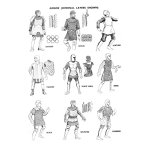Beoric
8, 8, I forget what is for
Yeah, no. Gothic plate included, but was not limited to tournament armor.I generally would invert this and kick full-plate to the curb. "Full plate" is intended for jousting tournaments and maybe the battle-field, but not traveling or adventuring in dungeons. It's too bulk for long travel and your fighter would almost certainly not be wearing it and have it packed on a beast of burden. Hence the reason for just including plate mail in pre-UA D&D.
Part of the problem is that most of the armor types posited by Gygax likely never existed, at least not in the form he described. Studded leather never existed, and was likely a misunderstanding of the rivets on brigandine, which actually gave a lot more protection. Ring mail was likely a misinterpretation of artistic renditions of chain mail. "Chain mail" was actually called "mail". Splint "mail" was actually just used for limb armor. I don't know what banded armor was supposed to be, but my best guess is lame and/or a coat of plates.
"Plate mail" may have been any of a number of combined mail-and-plate armor, none of which were actually European. The picture in the 1e DM Adventure Log
 looks what Palladium described as "plate over mail", literally reinforcing plates worn over a mail hauberk and cuisses during a transitional period before armor-smithing was up to the task of making gothic plate. It is described in Wikipedia as
looks what Palladium described as "plate over mail", literally reinforcing plates worn over a mail hauberk and cuisses during a transitional period before armor-smithing was up to the task of making gothic plate. It is described in Wikipedia as
and probably looked like the cuirass and brassarts of this image from the "splint armor" page linked above:Single plates of metal armour were again used from the late 13th century on, to protect joints and shins, and these were worn over a mail hauberk. Gradually the number of plate components of medieval armour increased, protecting further areas of the body, and in barding those of a cavalryman's horse. Armourers developed skills in articulating the lames or individual plates for parts of the body that needed to be flexible, and in fitting armour to the individual wearer like a tailor.

It would have been heavy and cumbersome, being a full suit of mail over a full gameson, all of which had various other plates (courass, grieves, vambraces, brasssarts, rondels) strapped overtop or wired in.
Late medieval plate like gothic plate was later that, and likely superior to, either type of armor that Gygax may have been referring to as "plate mail" (and is in fact what the paladin in hell was wearing). It also much easier to move in than the 6" movement rate that is attributed to platemail; see this video. [Someone need to explain to me the syntax of imbedding video.]